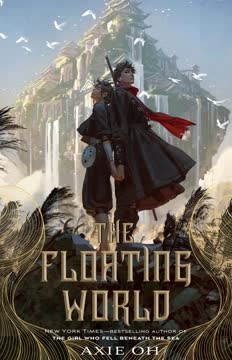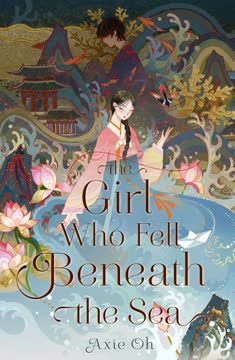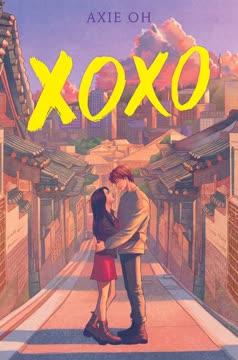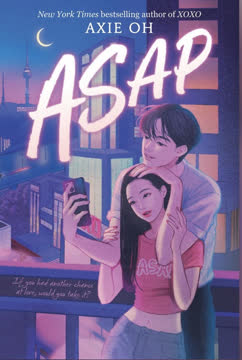Plot Summary
Masks and Magic Unveiled
Ren, a young performer in a traveling troupe, lives a life of acrobatics, storytelling, and disguise. She wears a mask to hide her identity and, more importantly, her forbidden magic—an elemental Light that stirs within her. Her family, especially Auntie, warns her never to use her powers in public, fearing the attention of those who once hunted her. But Ren's longing for freedom and belonging is as strong as her magic, and a single slip during a performance sets her on a path that will upend her world.
Shadows Beneath the Floating World
Beneath the Floating World—a sky-bound empire of privilege—lies the Under World, a city of perpetual night, smoke, and poverty. Here, Sunho, a sword-for-hire with a mysterious past and supernatural abilities, navigates the criminal underbelly. He is haunted by amnesia, a demonic presence within, and the memory of a lost brother. When he's hired by a Sareniyan captain to find a girl connected to a miraculous light, Sunho is drawn into a web of mercenaries, revolutionaries, and political intrigue.
The Demon's Attack
Ren's troupe arrives in Gorye Village, where a demon attacks during a festival, killing loved ones and infecting her beloved Little Uncle with a strange, fatal illness. The demon's blood is blue, and so is the blood of the wounded. Ren's magic flares in defense, unleashing a silver light that is seen for miles. The attack is not random—it is a harbinger of a greater darkness spreading from the Under World.
Flight and Fractures
With her uncle dying and her family shattered, Ren is wracked by guilt and fear. She learns the demon was once human, transformed by something unnatural. Determined to save her uncle, she sets out alone, guided by anger and the hope of a cure. Meanwhile, Sunho, on a train with mercenaries, is swept into a violent massacre as rival bounty hunters turn on each other, and monstrous experiments escape.
The Silver Light
Ren's use of her Light draws the attention of the Sareniyan regime and the Floating World's nobility. Mercenaries, including Sunho, are dispatched to find the source of the silver light. The general, a tyrant who seized power after the queen's death, seeks to destroy any threat to his rule, especially the rumored surviving princess. The hunt for Ren becomes a race between those who would save her and those who would exploit or kill her.
Mercenaries on the Hunt
Sunho, wounded and amnesiac, is found by Ren in a reed field. She heals him, discovering his blood is also blue. They form a wary alliance, each hiding their true identity and purpose. As they journey together, pursued by mercenaries and outlaws, they encounter rebels, storytellers, and the broken people of the Occupied Territories. Their bond deepens, even as secrets threaten to tear them apart.
The Reed Field Encounter
Ren and Sunho's partnership is tested by attacks from both monsters and men. They save each other repeatedly, and their shared trauma and loneliness draw them closer. Ren's compassion and Sunho's protectiveness create a fragile trust. Yet, both are haunted by the knowledge that Sunho was hired to find a girl—possibly Ren herself—and that his own past is tied to the same experiments that created the demons.
Outlaws and Old Stories
Taking refuge with a band of outlaws, Ren and Sunho perform stories and dances, sharing tales of celestial maidens and lost wings. The myth of the Woodcutter and the Celestial Maiden becomes a motif, reflecting Ren's own stolen freedom and the world's longing for hope. The outlaws' suffering under Sareniyan rule mirrors Ren's internal struggle: to reclaim her power or remain hidden.
The Train of Blood
Sunho's memories return in fragments: a childhood in the Under World, conscription as a child soldier, and horrific experiments with mithril that turned children into monsters. He remembers a brother, Junho, and friends lost to violence. The train massacre, the blue blood, and the monstrous transformations are all linked to a secret laboratory and a vengeful scientist.
The Under World's Secrets
In the Under World, Ren and Sunho join forces with rebels Yurhee and Tag, who seek to expose the regime's crimes. They discover the black-winged symbol of a secret organization and the existence of a serum that transforms humans into demons. The Sareniyan general's grip on power is threatened by rumors of the celestial maiden's return, and the city teeters on the brink of revolution.
The Scientist's Sin
Ren and Sunho infiltrate the mithril mines, uncovering the laboratory where children were experimented on. The scientist, driven by grief and vengeance, created the serum that turned Sunho's friends—and possibly his brother—into demons. The cure for the blue-blooded illness exists, but at a terrible cost: the scientist demands Ren's blood, believing her celestial power is the key to salvation or destruction.
The Cure and the Cost
Ren secures the cure for her uncle, but Sunho is forced to confront the demon that was once his friend. In a devastating battle, he must choose between mercy and survival, ultimately killing his friend to save others. The trauma of this act, and the revelation that he himself killed his brother while transformed, shatters Sunho. Ren, too, is forced to choose between vengeance and forgiveness as she faces her own legacy.
The Sky Door Opens
The Festival of Light brings all factions to a climax. Ren is captured and brought to the Floating World, where the general plans to execute her as an imposter. The Sky Door—the portal between worlds—opens, and the people witness Ren's true power. Sunho, climbing from the Under World, arrives in time to challenge the general, but is cast down into the abyss.
The General's Betrayal
Ren confronts the general, exposing his murder of her mother and the lies that have kept the world in darkness. The myths of the celestial maiden and the woodcutter are revealed as allegories for power, loss, and the longing for freedom. Ren's refusal to kill the general with her Light marks a turning point: she will not become what she hates.
Wings of the Celestial Maiden
In a moment of ultimate courage, Ren leaps into the abyss after Sunho. Her wings manifest, and she saves him, revealing herself as the true celestial maiden. Their love, forged in suffering and hope, becomes a beacon for both worlds. The people witness her flight, and the myth becomes reality.
The Fall and the Flight
Sunho, transformed into a demon by grief and guilt, is brought back by Ren's love and Light. Together, they return to the world, breaking the cycle of violence and vengeance. The general is overthrown, and Ren is offered the throne, but she chooses to return home, seeking healing and understanding rather than power.
The Demon Within
Sunho and Ren confront the darkness within themselves and each other. They learn that true strength lies not in power or revenge, but in compassion, forgiveness, and the courage to choose one's own destiny. Their journey is not over, but they face the future together, with hope.
Homecoming and Farewell
Ren returns to her village, bringing the cure to her uncle and reuniting with her chosen family. She mourns those lost, honors those who saved her, and prepares to face the challenges ahead. Sunho, too, finds a place of belonging, no longer defined by his past or his pain. Together, they look to the horizon, ready to write a new story.
Characters
Ren (Sareniya)
Ren is the last descendant of the celestial maidens, raised in hiding as a troupe performer. She is defined by her longing for belonging, her guilt over the suffering of those she loves, and her struggle to accept her own power. Ren's journey is one of self-discovery: from a masked girl afraid of her past, to a young woman who claims her identity and chooses compassion over vengeance. Her relationships—with her adoptive family, with Sunho, and with her lost mother—are the emotional core of the story. Ren's greatest fear is losing herself to the expectations and violence of others, but her greatest strength is her ability to love and forgive.
Sunho
Sunho is a former child soldier, amnesiac, and survivor of horrific experiments that turned children into monsters. He is haunted by the memory of his brother, the guilt of his own actions while transformed, and the demonic presence within him. Sunho's psychological journey is one of self-acceptance: learning that he is not defined by his trauma or his power, but by his choices. His relationship with Ren is transformative, offering him hope, love, and a reason to fight for the future. Sunho's arc is a meditation on the cost of violence and the possibility of redemption.
Auntie
Auntie is Ren's adoptive guardian, a performer who teaches Ren discipline, caution, and the value of family. She is both nurturing and strict, driven by the trauma of the past and the need to keep Ren safe. Auntie's love is the foundation of Ren's resilience, but her fear also limits Ren's growth. Her character embodies the tension between safety and freedom.
Little Uncle (Wook)
Little Uncle is Ren's closest companion, a source of humor, support, and courage. His injury and illness are the catalyst for Ren's quest, and his unwavering faith in her gives her strength. Little Uncle's arc is one of vulnerability and recovery, symbolizing the cost of violence and the hope of healing.
Big Uncle
Big Uncle is the heart of Ren's found family, offering wisdom, kindness, and unconditional love. His death in the demon attack is a profound loss for Ren, shaping her journey and her understanding of sacrifice.
Jaeil
Jaeil is the Sareniyan captain who hires Sunho and manipulates events from the shadows. Once Ren's childhood friend, he is now torn between loyalty to his tyrant father and his own sense of justice. Jaeil's psychological complexity lies in his inability to save Ren or himself, embodying the tragedy of those caught between power and conscience.
The General (Iljin)
The general is the architect of the Floating World's darkness: a usurper who murdered the queen, unleashed war, and sanctioned monstrous experiments. He is driven by fear, ambition, and a need to control. Psychologically, he represents the cycle of violence and the dangers of unchecked power. His downfall is both a personal and political reckoning.
Yurhee
Yurhee is a rebel leader in the Under World, quick-witted and fiercely protective of her found family. She offers Ren and Sunho sanctuary, guidance, and a model of resistance. Yurhee's character is a study in resilience and the power of chosen kinship.
Tag
Tag is Yurhee's partner, a skilled mechanic and strategist. He is emotionally reserved but deeply loyal, providing stability and support. Tag's arc is one of opening up to trust and friendship, especially with Sunho.
The Scientist
The unnamed scientist is the architect of the mithril experiments, driven by grief over his brother's death and a desire for revenge. His actions unleash horrors on both worlds, and his psychological unraveling is a cautionary tale about the dangers of obsession and the misuse of power.
Plot Devices
Dual Worlds and Social Stratification
The Floating World and the Under World are literal and symbolic opposites: one of light, luxury, and myth; the other of darkness, poverty, and survival. This duality structures the narrative, highlighting themes of class, power, and the cost of utopia. The Sky Door serves as both a physical and metaphorical threshold between worlds, and the journey between them is a rite of passage for the characters.
Masks, Identity, and Transformation
Masks—literal and figurative—are central to the story. Ren's mask protects her but also limits her; Sunho's amnesia and demonic form are masks of trauma. The plot is propelled by the gradual unveiling of true identities, culminating in Ren's transformation into the celestial maiden and Sunho's confrontation with his own monstrous self. The motif of transformation is both magical and psychological.
Myths and Storytelling
The recurring tale of the Woodcutter and the Celestial Maiden is both a plot device and a thematic mirror, reflecting the characters' struggles with freedom, love, and loss. Storytelling is a means of survival, resistance, and self-definition, and the power of myth is both a weapon and a source of hope.
Foreshadowing and Parallelism
The narrative is rich with foreshadowing: Ren's early use of magic predicts the world-shaking events to come; Sunho's memories hint at the true nature of the demons. Parallel journeys—Ren's quest to save her uncle, Sunho's search for his brother—intertwine, reinforcing the story's themes of sacrifice, redemption, and the search for home.
The Cure and the Cost
The quest for a cure—whether for Little Uncle's illness or the world's corruption—drives the plot, but every solution comes with a price. Ren's blood, Sunho's memories, and the lives lost in the pursuit of power all underscore the story's meditation on the cost of healing and the dangers of easy answers.
Analysis
The Floating World is a sweeping fantasy that interrogates the legacy of violence, the burden of power, and the possibility of redemption. Through the intertwined journeys of Ren and Sunho, Axie Oh explores how trauma shapes identity, how love and chosen family can heal even the deepest wounds, and how myths can both imprison and liberate. The novel's dual-world structure is a powerful metaphor for social inequality and the hidden costs of utopia. Its use of masks, transformation, and storytelling as both plot devices and psychological motifs invites readers to reflect on the stories we tell ourselves—and the ones we must rewrite to break cycles of pain. Ultimately, the book argues that true strength lies not in vengeance or power, but in compassion, forgiveness, and the willingness to leap into the unknown for those we love. The Floating World is both a thrilling adventure and a moving meditation on what it means to be human in a world of gods and monsters.
Last updated:
FAQ
0. Synopsis & Basic Details
What is The Floating World about?
- A Journey of Self-Discovery: The Floating World follows Ren, a young woman raised in a traveling troupe, who must confront her hidden celestial powers and a tragic past tied to the sky-bound Floating World. Her quest begins when a mysterious demon attacks her village, infecting her beloved Little Uncle with a strange, blue-blooded illness.
- Worlds Divided by Darkness: Beneath the opulent Floating World lies the Under World, a city of perpetual night and poverty. Here, Sunho, an amnesiac sword-for-hire with supernatural abilities and a "Demon" within, is hired to find a girl connected to a miraculous light—a light that emanates from Ren.
- Unraveling a Conspiracy: As Ren and Sunho's paths intertwine, they uncover a vast conspiracy involving a tyrannical general, a vengeful scientist, and horrific experiments that transform humans into monsters. Their intertwined destinies force them to confront personal demons, make impossible choices, and ultimately decide the fate of two worlds.
Why should I read The Floating World?
- Rich World-Building & Mythology: Dive into a vividly imagined world split between a celestial realm and a gritty underworld, steeped in Korean-inspired mythology and folklore, offering a fresh take on classic fantasy tropes. The narrative seamlessly weaves ancient tales like "The Woodcutter and the Celestial Maiden" into a modern, high-stakes adventure.
- Deep Emotional Resonance: Experience a story that delves into profound themes of trauma, identity, and chosen family. Readers will connect with Ren's struggle to embrace her power and Sunho's journey to reclaim his memories and control the darkness within, finding hope and healing in unexpected places.
- Thrilling Action & Intrigue: From acrobatic escapes and sword fights to political machinations and monstrous transformations, The Floating World delivers relentless action and suspense. The intricate plot, filled with subtle foreshadowing and parallelism and moral dilemmas, keeps readers guessing until the very end.
What is the background of The Floating World?
- A Society of Stark Division: The story is set in a world sharply divided between the Floating World, a realm of light, privilege, and ancient celestial lineage, and the Under World, a subterranean city of darkness, poverty, and industrial pollution. This stratification is a direct result of Sareniyan imperial rule, which has exploited the Under World for its mithril resources.
- Post-Usurpation Political Climate: Ten years prior to the main narrative, General Iljin usurped power in the Floating World by murdering the celestial queen (Ren's mother) and her heir. He now rules through military might, maintaining a fragile peace with the Floating Council while secretly plotting to consolidate absolute control and wage war against the northern empire of Volmar.
- Mithril's Dual Nature: Mithril, the luminous blue mineral that keeps the Floating World aloft, is also a source of immense danger. In the Under World, its mining and processing create toxic smoke, and in the hands of a vengeful scientist, it becomes the key ingredient in a serum that transforms humans into monstrous "demons," fueling both the general's war efforts and the scientist's personal vendetta.
What are the most memorable quotes in The Floating World?
- "Even in darkness, there is always light.": This quote, spoken by Sunho's brother Junho in a pivotal memory (Chapter 30), encapsulates the core theme of resilience and hope in the face of overwhelming despair. It becomes Sunho's guiding principle, reminding him that even with the "Demon" inside, he can choose to fight for goodness.
- "If you had wings, I'd want to see you fly.": Sunho's heartfelt response to Ren's playful question (Chapter 19) beautifully foreshadows her ultimate transformation into the celestial maiden. It signifies his unconditional acceptance and desire for her freedom, contrasting sharply with the woodcutter's act of stealing the maiden's wings in the myth.
- "I worked hard to be nobody.": Ren's defiant declaration to Sunho (Chapter 22) reveals her deep-seated desire to escape her royal lineage and the burdens of her past. It highlights her journey from a hidden princess to a self-defined individual, emphasizing the theme of choosing one's own identity over a predetermined destiny.
What writing style, narrative choices, and literary techniques does Axie Oh use?
- Alternating Perspectives & Close Third-Person POV: The narrative primarily alternates between Ren's and Sunho's close third-person perspectives, allowing readers deep insight into their individual psychological states, fears, and motivations. This choice builds empathy and highlights their parallel journeys of self-discovery and healing.
- Sensory-Rich & Evocative Prose: Axie Oh employs vivid, poetic language to create immersive settings, from the "gilded sea" of reed fields (Chapter 12) to the "inky" darkness of the Under World (Chapter 22). Her descriptions often appeal to multiple senses, drawing readers into the characters' experiences and the distinct atmospheres of each world.
- Symbolism & Mythological Allusion: The novel is rich with symbolism, particularly through recurring motifs like masks, wings, light, and darkness. The frequent allusions to the "Woodcutter and the Celestial Maiden" myth serve as a powerful literary device, providing thematic depth and foreshadowing character arcs, inviting readers to interpret how ancient stories shape contemporary destinies.
1. Hidden Details & Subtle Connections
What are some minor details that add significant meaning?
- The Blue Flower's Symbolic Resonance: Ren's purchase of a blue cosmos flower in the Under World (Chapter 25), despite its eventual wilting, subtly connects her to Sunho and the unique blue light of his world. The flower, a symbol of peace and cosmic order, mirrors the blue glow in Sunho's eyes and the mithril, hinting at a deeper, almost fated connection between them and the potential for harmony between their disparate worlds.
- Auntie's Ankle Injury as Foreshadowing: Auntie's twisted ankle (Chapter 1) is initially presented as a minor inconvenience, forcing Ren to play the flute instead of performing. However, it subtly foreshadows the physical and emotional vulnerabilities that will plague the caravan, highlighting how even small weaknesses can have significant consequences when larger, unseen threats emerge, ultimately leading to Big Uncle's death and Little Uncle's illness.
- The Black Wing Emblem's Recurring Mystery: The "black wing, folded in half" symbol (Chapter 3, 9, 23) appears on the map stolen from the mithril factory, on crates on the train, and is later revealed to be the emblem of Junho's "Black Robes" unit. This seemingly minor detail consistently links the mysterious experiments, the demons, and Sunho's lost brother, serving as a breadcrumb trail for both the characters and the reader to uncover the true origins of the monstrous transformations.
What are some subtle foreshadowing and callbacks?
- Ren's Fear of Falling and Her Mother's Fate: Ren's intense, paralyzing fear of heights, particularly when looking into ravines (Chapter 5, 18), is a subtle callback to her repressed memory of her mother's death. This deep-seated trauma, revealed in Chapter 18, foreshadows her ultimate act of courage: leaping into the Sky Door to save Sunho (Chapter 35), directly confronting and overcoming the source of her greatest fear.
- Sunho's "Hatred" for the Floating World: When Sunho first sees the Floating World from the train (Chapter 9), he feels an "odd burning in his chest... A feeling like hatred." This seemingly out-of-place emotion subtly foreshadows the revelation of his brother's connection to the celestial maiden (Chapter 21) and the Sareniyan nobility, hinting at a deeper, personal grievance against the Floating World that he has yet to remember.
- The Woodcutter's Flute and the Leader's Instrument: The leader of the outlaws plays a flute (Chapter 17) to accompany Sunho's sword dance, a direct callback to Ren's own role as a flutist in her troupe (Chapter 1). This shared musicality subtly highlights the common humanity and artistic spirit that transcends the divisions of the world, suggesting that even in exile, culture and connection endure.
Review Summary
The Floating World is a YA fantasy novel inspired by Korean mythology, receiving mostly positive reviews. Readers praise the immersive world-building, likening it to Studio Ghibli films. The story follows Ren, an acrobat with hidden powers, and Sunho, an amnesiac soldier. Their slow-burn romance and character development are highlights for many. While some found the pacing uneven and the characters occasionally immature, most reviewers eagerly anticipate the sequel. The book's blend of magic, demons, and political intrigue kept readers engaged, despite some minor criticisms.
Download PDF
Download EPUB
.epub digital book format is ideal for reading ebooks on phones, tablets, and e-readers.








